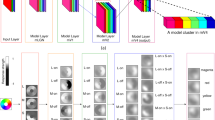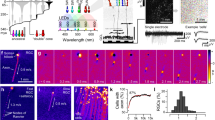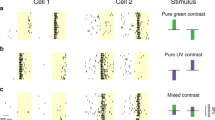Abstract
WHEN the colour of a visual stimulus is repetitively alternated between say red and green, the percept evoked depends upon the temporal frequency of repetition. At very low frequencies (for example, 1–2 Hz), the repetitive change in colour is readily apparent. But at frequencies above about 10 Hz, no changes in colour are perceived; the stimulus in this case would appear a uniform yellow but would still seem to be flickering in brightness. Observations of this kind suggest that the colour of a stimulus may be analysed by a set of channels different from that analysing the brightness or flicker. The flicker or brightness channels respond to higher temporal frequencies of flicker than do the colour channels. This idea was confirmed by King-Smith1 who has described how the sensitivity to coloured flashes of light changes with flash duration. He further described the subjective appearance of the flash, and concluded that a stimulus was not necessarily detected by the same channels as those that detected its colour. When the flash was brief, the stimuli usually looked achromatic, except when the wavelength was below about 490 nm. The intensity of the flash had to be raised above the detection threshold before the colour could be perceived. At longer flash durations, the colour was apparent as soon as the flash was detectable. The channels signalling the colour of a stimulus have a longer ‘integration time’ than those giving an achromatic percept. This kind of experiment examines differences in the high temporal frequency behaviour of the two sets of channels. It is of interest to examine the low temporal frequency behaviour as well because recent neuro-physiological investigations of the monkey's visual system make use of this behaviour in classifying neurones2–5. Some neurones give a sustained response to prolonged presentation of a stationary stimulus; others respond only transiently to the stimulus onset. I show here that human colour channels give sustained responses while the flicker or brightness channels give transient responses.
This is a preview of subscription content, access via your institution
Access options
Subscribe to this journal
Receive 51 print issues and online access
$199.00 per year
only $3.90 per issue
Buy this article
- Purchase on Springer Link
- Instant access to full article PDF
Prices may be subject to local taxes which are calculated during checkout
Similar content being viewed by others
References
King-Smith, P. E. Nature 255, 69–70 (1975).
Gouras, P. J. Physiol., Lond. 199, 533–547 (1968).
Gouras, P. J. Physiol., Lond. 204, 407–419 (1969).
De Monasterio, F. M., Gouras, P. & Tolhurst, D. J. Vision Res. 16, 674–678 (1976).
Dreher, B., Fukada, Y. & Rodieck, W. J. Physiol., Lond. 258, 433–452 (1976).
Tolhurst, D. J. Vision Res. 15, 1151–1155 (1975).
Graham, C. H. in Vision and Visual Perception (ed. Graham, C. H.) ch. 3 (Wiley, New York, 1965).
Guth, S. L. Vision Res. 7, 319–328 (1967).
Author information
Authors and Affiliations
Rights and permissions
About this article
Cite this article
TOLHURST, D. Colour-coding properties of sustained and transient channels in human vision. Nature 266, 266–268 (1977). https://doi.org/10.1038/266266a0
Received:
Accepted:
Published:
Issue Date:
DOI: https://doi.org/10.1038/266266a0
This article is cited by
-
Magnetophosphenes: a quantitative analysis of thresholds
Medical & Biological Engineering & Computing (1980)
Comments
By submitting a comment you agree to abide by our Terms and Community Guidelines. If you find something abusive or that does not comply with our terms or guidelines please flag it as inappropriate.



